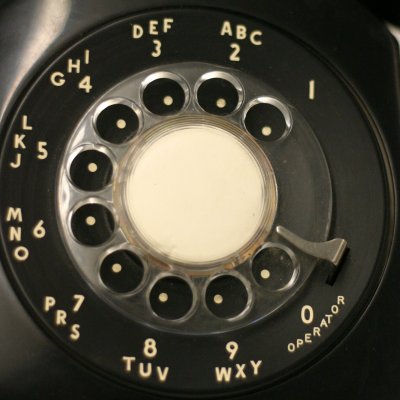Or: B’rar Radical Meets the Rotary Oscillator

You know that book “Everything I Needed To Know I Learned in Kindergarten”? It’s a big, fat lie! Everything I learned in Kindergarten was important, I’ll grant you, but most of the really important things I’ve learned I learned much later. That doesn’t mean, of course, that the lesson wasn’t there all along waiting for me to learn it. It just means that, in the grand scheme of things, learning not to eat the paste really doesn’t rank that high.
Now, just because I didn’t learn important lessons in Kindergarten doesn’t mean you can’t learn important leassons from my time in Kindergarten. Plenty of people have. Take Mrs. Kingenhoffer, for example…
Mrs. Klingenhoffer was a teacher’s aide who worked with my Kindergarten teacher, and to her fell the rather important task of teaching us how to dial our telephone numbers. Oh, yes kiddies, back then telephones had rotary dials exactly like the one on the right. They also had to have a cord connecting them to a special wall socket. Which connected to a special wire connected to the house. Which connected to a special wire connected to a telephone pole near the steet. Which held up a special wire that connected every telephone in the whole wide world. Even the part you talked and listened through had a special wire connecting it to the part you dialed. In fact, the only wireless phones were the Fisher-Price ones. Oh, and the only sort of phone a kid under the age of 21 could hope to have was one of those Fisher-Price ones.
My school was, apparently, one of those state-of-the-art, high-tech schools. What this means is that we all had to go with Mrs. Kingenhoffer to a “special” room to learn how to dial the phone. It was a “special” room because it had a lot of stuff in it. Most importantly it was where the Twenty-Seven-Foot Cardboard Telephone was stored. I realize now that the Twenty-Seven-Foot Cardboard Telephone was actually only a Four-Foot Cardboard Telephone, which curiously enough is a bit more than 27-times bigger than a real telephone, but when you’re only three and a half feet tall a four foot telephone can be a little intimidating.
Typically, the lesson began with Mrs. Klingenhoffer explaining the process of dialing the phone, and then demonstrating the act with the Twenty-Seven Foot Cardboard Telephone. When she was done only a complete idiot would not understand how to dial a phone. Then, it was our turn. That is, it would be our turn as soon as Mrs. Klingenhoffer got us organized—to avoid any chaos you see.
Organizing a Kindergarten classroom usually involves making the kids line up according to some arbitrary measure—such as height, or alphabetically, or reverse alphabetically, or by shoe size. Being slightly less than average by amost every measure, I was usually in the middle of the line. This could have been God’s way of saying, “Pay attention now, so you don’t look like a complete idiot when it’s your turn!” I never paid attention.
The process was quite simple. A child would step toward the Twenty-Seven Foot Cardboard Telephone and Mrs. Klingenhoffer would ask them their telephone number. After reciting the number the child was directed to dial the number using the cardboard dial tacked to the Twenty-Seven Foot Cardboard Telephone. And that was it. Walking and chewing gum at the same time took more practice.
When my turn came I nervously approached Mrs. Klingenhoffer—my eyes were locked on her because that giant cardboard telephone thing was freaking me out. She asked me to recite my telephone number. “Five—Five—Five,” I said. “Oh—Three—Three—Two—One.”
“That’s too many numbers,” Mrs. Klingenhoffer said calmly. “Try again.”
“Five—Five—Five—Oh—Three—Three—Two,” I said, suddenly encouraged by the encouraging expression on Mrs. Klingenhoffer’s face. “—One.”
“That’s too many numbers Anthony”—she always called me ‘Anthony’—“try again,” she said, gray hairs appearing on the fringes. This fragment of the scene repeated itself several times. Each time Mrs. Klingenhoffer became more frustrated and her hair grew slightly grayer. Each time I became more firmly convinced that Mrs. Klingenhoffer was a complete idiot. Each time, Mrs. Klingenhoffer asked me to try again.
“Five–Five–Five–Oh–Three–Three–Two,” I said finally, pausing at this point because I was really encouraged by that encouraging expression she kept getting at that point. After what seemed like an hour of Mrs. Klingenhoffer looking at me as if a giant shoe was about to drop on her head, she looked at the Twenty-Seven Foot Cardboard Telephone nervously. “—One!” I finished.
The exact details of what happened next are a bit blurry; mostly because they happened so fast. I was carted off to the principal’s office so I’m not sure what happened to Mrs. Klingenhoffer or the Twenty-Seven Foot Cardboard Telephone.
The moral of my story is, of course: Never argue with an idiot!

